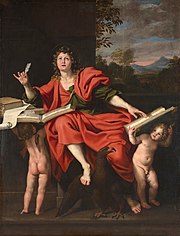Book of Signs
| Part of a series of articles on |
| John in the Bible |
|---|
 |
| Johannine literature |
| Authorship |
| Related literature |
| See also |
In Christian scholarship, the Book of Signs is a name commonly given to the first main section of the Gospel of John, from 1:19 to the end of Chapter 12. It follows the Hymn to the Word and precedes the Book of Glory. It is named for seven notable events, often called "signs" or "miracles", that it records.[1]
Location in text
There is a widespread scholarly view that the Gospel of John can be broken into four parts: a prologue, (John 1:–1:18), the Book of Signs (1:19 to 12:50), the Book of Glory (or Exaltation) (13:1 to 20:31) and an epilogue (chapter 21).[1]
John 20:30 Therefore many other signs Jesus also performed in the presence of the disciples, which are not written in this book; 31 but these have been written so that you may believe that Jesus is the Christ, the Son of God; and that believing you may have life in His name.
It is this indication by the author of the gospel that the signs are selected, which leads to the examination of them as a sequence of seven.
Seven Signs
- Changing water into wine at Cana in John 2:1–11 – "the first of the signs"
- Healing the royal official's son in Capernaum in John 4:46–54
- Healing the paralytic at Bethesda in John 5:1–15
- Feeding the 5000 in John 6:5–14
- Jesus walking on water in John 6:16–24
- Healing the man blind from birth in John 9:1–7
- The raising of Lazarus in John 11:1–45
The seven signs are seen by some scholars and theologians as evidence of new creation theology in the Gospel of John, the resurrection of Jesus being the implied eighth sign, indicating a week of creation and then a new creation beginning with the resurrection.[4]
Other lists of seven signs
Some disagree with this list of seven signs. John Marsh and Stephen Smalley, amongst others, have suggested six initial signs (seeing the walking on the water as part of feeding the 5000, rather than a separate sign in itself), and that the seventh sign is the crucifixion of Jesus and the resurrection appearance to Thomas (20:26–29).[5] Anthony T. Selvaggio replaces walking on water with the cleansing of the Temple because John 2:18 includes the word "sign".[6]
Eighth sign
Others, such as John Hutchinson[7] and E. W. Bullinger, have emphasized a sequence of eight signs, concluding with the miraculous catch of fish in John 21:1–14.[8]
References
- ^ a b Köstenberger, Andreas J.; Kellum, Leonard Scott; Quarles, Charles L. (2009). "The Gospel According to John". The Cradle, the Cross, and the Crown: An Introduction to the New Testament. Nashville: B&H Publishing Group. p. 305. ISBN 978-0805443653. Retrieved 21 June 2016.
- ^ The Bible Knowledge Commentary John F. Walvoord and Roy B. Zuck 1983 ISBN 0-88207-812-7 p. 269
- ^ von Dehsen, Christian D. "The Gospel of John". Oxford Biblical Studies Online. Oxford University Press. Retrieved February 7, 2020.
This section of the Gospel of John is characterized by seven "signs,"
- ^ Rob Bell, Beginning in the Beginning, Poets Prophets & Preachers
- ^ John Marsh, Saint John (Pelican New Testament Commentary, 1968) p. 65, Stephen Smalley in The Oxford Companion to the Bible, (OUP, 1993) p. 373
- ^ Anthony T. Selvaggio, The Seven Signs (Reformation Heritage Books, 2010) pp. 5–6.
- ^ John Hutchison, Our Lord's Signs in St. John's Gospel: Discussions Chiefly Exegetical and Doctrinal on the Eight Miracles in the Fourth Gospel (printed Edinburgh, 1892)
- ^ Bullinger Companion Bible Eight Signs in the Gospel of John
